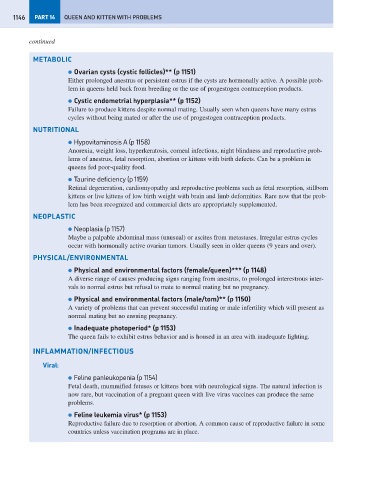Page 1154 - Problem-Based Feline Medicine
P. 1154
1146 PART 14 QUEEN AND KITTEN WITH PROBLEMS
continued
METABOLIC
● Ovarian cysts (cystic follicles)** (p 1151)
Either prolonged anestrus or persistent estrus if the cysts are hormonally active. A possible prob-
lem in queens held back from breeding or the use of progestogen contraception products.
● Cystic endometrial hyperplasia** (p 1152)
Failure to produce kittens despite normal mating. Usually seen when queens have many estrus
cycles without being mated or after the use of progestogen contraception products.
NUTRITIONAL
● Hypovitaminosis A (p 1158)
Anorexia, weight loss, hyperkeratosis, corneal infections, night blindness and reproductive prob-
lems of anestrus, fetal resorption, abortion or kittens with birth defects. Can be a problem in
queens fed poor-quality food.
● Taurine deficiency (p 1159)
Retinal degeneration, cardiomyopathy and reproductive problems such as fetal resorption, stillborn
kittens or live kittens of low birth weight with brain and limb deformities. Rare now that the prob-
lem has been recognized and commercial diets are appropriately supplemented.
NEOPLASTIC
● Neoplasia (p 1157)
Maybe a palpable abdominal mass (unusual) or ascites from metastases. Irregular estrus cycles
occur with hormonally active ovarian tumors. Usually seen in older queens (9 years and over).
PHYSICAL/ENVIRONMENTAL
● Physical and environmental factors (female/queen)*** (p 1148)
A diverse range of causes producing signs ranging from anestrus, to prolonged interestrous inter-
vals to normal estrus but refusal to mate to normal mating but no pregnancy.
● Physical and environmental factors (male/tom)** (p 1150)
A variety of problems that can prevent successful mating or male infertility which will present as
normal mating but no ensuing pregnancy.
● Inadequate photoperiod* (p 1153)
The queen fails to exhibit estrus behavior and is housed in an area with inadequate lighting.
INFLAMMATION/INFECTIOUS
Viral:
● Feline panleukopenia (p 1154)
Fetal death, mummified fetuses or kittens born with neurological signs. The natural infection is
now rare, but vaccination of a pregnant queen with live virus vaccines can produce the same
problems.
● Feline leukemia virus* (p 1153)
Reproductive failure due to resorption or abortion. A common cause of reproductive failure in some
countries unless vaccination programs are in place.

